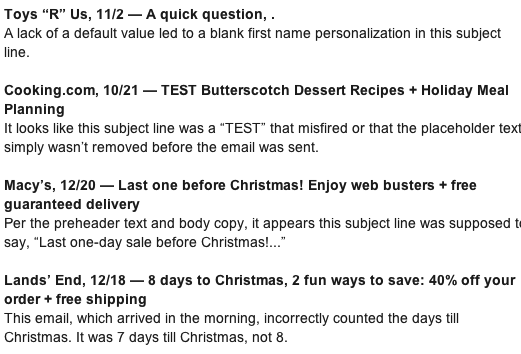Basic tactics for building trust in your brand: Part 2
Part 1 of this article outlined the role of familiarity, transparency and accountability in building trust in and through your email program.
It also mentioned another set of appropriate "trust" tactics: demonstrating quality and consistency.
Well, yeah....you mean keep subscribers happy with worthwhile content or top deals on a regular basis? You might have heard that advice before.
Actually I don't mean (just) that.
Quality here refers to more than just "valuable content and/or offers". It also covers the quality of the whole email experience, which doesn't just depend on the actual nature of that content or offer, but also on its presentation and context. Here are four examples...
1. Email design functionality
We can argue long into the night about what makes an aesthetically pleasing email. But equally important is ensuring your email retains its functionality and clarity of communication at all times. Specifically:
This is where email design preview tools, like Litmus or Email on Acid come into their own. They let you answer those questions before you send out any emails, so you can take any necessary remedial action.
2. Email system functionality
This functionality issue also extends to the technical processes that subscribers encounter when joining or leaving a list and interacting with the emails.
Again, it should come as no surprise to realize that the email technology ought to, um, work.
In practice, though, we suffer from "set and forget" syndrome. Basic administrative functions and the surrounding messaging - like double opt-in confirmation emails and welcome messages - often get ignored after the initial setup. So...
- Do these processes still work as intended?
- Is the language used still relevant in terms of both content and audience?
- Do you check the images and links in email just before the send to make sure they're still the right ones?
Welcome messages, for example, may set expectations for your emails' focus and frequency. When that frequency and focus changes (which is not unusual), then we often forget to update that welcome messaging appropriately.
Subscriber interactions also need to work in a way that reflects subscriber expectations.
Do (un)subscribe processes and preference centers make intuitive sense to the subscriber and eliminate all uncertainty? Remember, the subscriber knows nothing of your email marketing operation and is probably not an email marketer nor a web specialist.
For example:
- If I click on a link, does it take me to where I expect to go? Does a "buy now" link next to a product offer actually take me to the relevant product/offer page? Or does it dump me unhelpfully on an index or category page?
- If I sign-up, is this action confirmed clearly...on a thank-you page or within an immediate welcome message?
- If I want to unsubscribe, is it obvious how to do this and is it clear whether I have succeeded or not?
3. Third-party confirmations
Quality is also demonstrated through the "approval" of third parties.
Testimonials and other forms of social proof likely have a positive impact on trust: "if 250,000 other people trusted this company with their email address, then so can I".
Make it easy for people to share your email content, an action that typically carries an implicit recommendation:
- Place "share" links to Twitter, Facebook and other networks on email landing pages.
- Post links to the hosted version of your email through your social network account, so others can recommend or redistribute the link to their own communities.
4. The email voice
As noted in Part 1, (positive) human interaction also breeds trust:
- Temper your use of jargon, corporate speak, or IT department speak and use a more human voice where you can.
- Pay particular attention here to template messages (like confirmation and transactional emails) that your ESP, software manufacturer or IT staff wrote.
- Avoid stupid spelling and grammar mistakes: in fact, do you have a review system in place to avoid the kind of mistakes that land you in Chad White's Oopsy Hall of Fame?
That last point about spelling and grammar should not be seen as advice to "write properly". A friendly, conversational style, for example, gives you leeway to ignore some of the more restrictive rules of grammar you learned in school. Like this. Or starting a sentence with an or.
Don't forget: email marketing success is not just about your email marketing
Nearly all talk about trust factors, response drivers and similar in email marketing focuses (surprise!) on the role of email marketing in driving success.
But an (uncomfortable) truth is that recipient perceptions of email and responses to email are heavily influenced by the existing non-email relationship with the sender.
That rather obvious broader context is rarely accounted for, despite its huge importance.
In terms of trust, you can do everything right with your emails, but if your customer service keeps letting people down, you're just banging your head against a brick wall. And, of course, this is why senders with a super customer relationship can "get away" with sub-optimal email practices.
That wider relationship - who are you? Can people trust you? Do people trust you? - pervades anything you might do with email. (And it works both ways, of course. What you do with email will also influence the wider "brand relationship").
So...do you have any tips on building trust with email?







